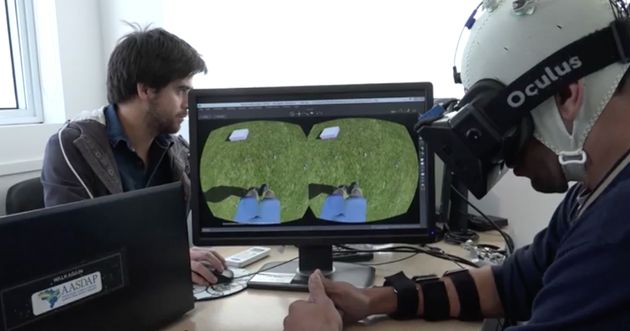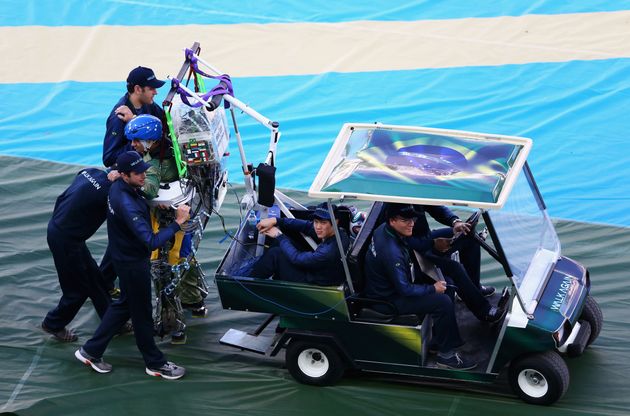A Robotic Suit Is Helping Paralyzed People Feel Their Legs Again
The finding came as a surprise to researchers.
A brain-controlled robotic suit has helped eight patients with severe spinal cord injuries recover some of their neurological function, scientists revealed Thursday in the journal Scientific Reports.
After 12 months of training in a lab, some of the participants started to regain sensations below the point of their spinal cord injury, and others also regained some muscle movement, according to the findings.
“As you can imagine, this is for us a very important milestone,” said Dr. Miguel Nicolelis of Duke University in Durham, North Carolina. “Nobody ever imagined that one day, we will be talking about the possibility of using brain-machine interface to induce partial neurological recovery in patients who have been diagnosed as having complete spinal cord injury.”
The robotic suit that the participants used consists of an exoskeleton that is guided by brain activity picked up by electrodes placed on the scalp. Signals from sensors in the lining of the exoskeleton travel to users’ forearms, where they still have sensation, so that they can receive some form of sensory feedback as they learn to walk with the exoskeleton.
The system also makes use of a virtual reality environment that enables the user to practice moving an avatar as they imagine walking.

AASDAP/ LENTE VIVA FILMES
The amount of neurological improvement the participants experienced is not enough to allow them to walk unassisted, but it can improve their quality of life, the researchers said.
“For almost a decade, [the patients] had remained on the most severe classification of spinal cord injury. By the end of 2014, half of these patients had to be reclassified as being partial paraplegic,” Nicolelis said in a press briefing.
Experts not involved in the study were excited by the findings.
“This is very cutting edge,” said Ela Plow, researcher at Cleveland FES Center and assistant professor at Cleveland Clinic’s Lerner College of Medicine. “Telling the patient that they are completely injured is a very difficult process, because that means almost telling them that they have no potential for recovery. But then they took these patients and gave them long-term retraining through a mix of techniques and realized that they could generate a process of partial recovery. That was very promising.”
Plow emphasized, however, that a lot of work remains to be done before such a complex intervention can be used in the clinic. “This is practical within a lab setting, but it may be difficult to translate this into the clinic right away,” she said.
Telling the patient that they are completely injured is a very difficult process, because that means almost telling them that they have no potential for recovery. But then they took these patients ... and realized that they could generate a process of partial recovery.Ela Plow, Cleveland FES Center, Cleveland Clinic Lerner College of Medicine
Edelle Field-Fote, a professor at Emory University School of Medicine and the director of spinal cord injury research at the Shepherd Center in Atlanta, shared that view: “From the perspective of realistic clinical application, the time, equipment, technical expertise required to do this 12-month intervention puts it out of reach of real-world clinical practice.”
However, the findings provide scientists and physicians with several takeaways, as well as some key questions to explore further. For example, would a longer training period give patients in the clinic as much benefit as the patients in this study? Should doctors start to incorporate VR into the traditional methods they use with patients?
“It provides us with a window into what we can start thinking about for our clinics,” Plow explained.
Rekindling Nerves
Going from zero to some functioning is rare in cases of severe spinal cord injury that are classified as “complete,” meaning that there’s a complete disconnect in the nerves of the spine at the level of injury. But it’s not unheard of.
Previous research has shown that in many cases of complete spinal cord injury, some nerves may survive the original trauma. These remaining nerves may have the potential to respond to training and recover some function.
The new findings are consistent with those of other labs and case reports that “have shown that with intensive training, it is possible to regain some walking function, even after very severe injury,” Field-Fote said.
Nicolelis and his colleagues believe that the intensive training may have helped reorganize the remaining neural connections in these patients.
“We might have triggered a process of reorganization in the cortex and spinal cord of these patients ― what we normally refer to as plasticity,” Nicolelis said. “We may have rekindled these remaining nerves to be able to send messages from the brain of the patients to the periphery.”
Mind-Controlled Artificial Bodies
Brain-machine interfaces are at the forefront of attempts to restore mobility to people with various forms of paralysis. Over the past few years, these attempts have included outfitting several patients withchips in their brains and robotic arms, and even restoring the sense of touch from a prosthetic hand. But the advances are still confined to the lab.
The new study is part of a long-term endeavor called the Walk Again Project, an international collaboration between researchers in Brazil, Germany, Switzerland and the United States. Two years ago, the researchers demonstrated the brain-controlled exoskeleton at the2014 FIFA World Cup opening ceremony in Sao Paolo, Brazil. There, with some help to stand upright, Juliano Pinto, a paralyzed person wearing the exoskeleton, kicked the first ball.

KEVIN C. COX/GETTY IMAGES
During training after the demonstration, “We started realizing the patients were experiencing an improvement in their neurological examinations,” Nicolelis said. “They started regaining sensitivity below the level of the lesion and started exhibiting voluntary movements.”
Seven of the eight patients in the study had what’s known as a Grade A spinal cord injury, meaning they had a complete lack of motor and sensory function below the level of injury. After the training, three of them saw enough neurological improvement to be reclassified to Grade C, which is reserved for patients who can show some voluntary muscle movement below the level of injury. Another patient with a Grade B injury was also reclassified to Grade C.
It’s not clear why the four other participants didn’t respond as significantly to the training. Also unclear is the exact mechanism underlying the patients’ partial neurological recovery.
Future research should focus on identifying the factors that contributed to better outcomes in certain patients, Plow said. That way, physicians can potentially identify which patients with complete spinal cord injuries have the best chance of partial neurological recovery.
No comments:
Post a Comment